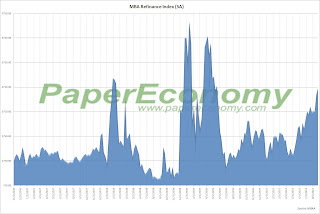It has been a while since I have updated you on the bank lending situation in China. This is not due to me slacking off (I'll admit to a slower pace of posts recently, but I have some good excuses, really) following this topic. The data source, People's bank of China, has suddenly been a little more reticent in publishing this data in English and as my Chinese language skills are a bit lacking this data series has languished....
Data released recently shows a continuing trend of
official slowing in the rate of loan growth. I put official in
italics because there appears to be some off balance tomfoolery going on. . .
From
Caixin Online:
Despite regulatory directives aimed at preventing banks from removing loans off their balance sheets to dodge credit restrictions, China's banks did not slow down their pace in packaging loans as wealth management products.
Banks and trusts cooperated on wealth management products, effectively allowing them to shirk their responsibilities toward credit limits imposed nationwide under the central government's macroeconomic controls.
In the first half 2010, according to trust company reports, the value of wealth management products cooperatively offered by banks and trusts rose to 2.6 trillion yuan, topping the previous year's 1.77 trillion yuan.
This amount combined with the 4.58 trillion yuan in on-the-books, new credit issued by banks in the first half brought total lending in China through June 30 to near the 7.5 trillion yuan limit set by the government for all 2010.
[The 4.58 trillion yuan number matches my data. Look at the 'wealth management products' value of 2.6 trillion. Greater than 50% of the 'on the books official' value of 4.58 trillion. Continuing . . ]
By charging fees as well as commissions of up to 2 percent, banks earn more than trusts when they jointly market bank-trust products. Moreover, by cooperating with trusts, banks keep customers otherwise unavailable due to credit controls, since off-book business doesn't require bank capital and thus avoids CBRC capital constraints.
When companies start hiding assets off balance sheet it rarely ends well.
If you are wondering where all that money is going, this
blog entry by staff at the World bank is stunning. Not only for the information presented but the absolute lack of surprise. (ht
Mish)
In Chenggong, there are more than a hundred-thousand new apartments with no occupants, lush tree-lined streets with no cars, enormous office buildings with no workers, and billboards advertising cold medicine and real estate services – with no one to see them.
I went to China in 2003 and I can assure you I NEVER saw a single piece of urban pavement that was not completely full of cars, trucks, bikes, scooters, etc at all times. I have mentioned empty Chinese cities before such as
Ordos. How many more empty cities in China are there? Andy Xie has wrote about this before. Here is
his latest article regarding the excess housing stock in China:
What distinguishes China’s property bubble from others is its unprecedented quantity dimension. China just doesn’t have any constraint limiting supply. The current debate about the quantity of empty flats is about the extent of quantity excess. The stock of empty flats measures the size of the quantity bubble. Taiwan experienced a price-cum-quantity bubble in late 1980s. At the time the market quantified the number of empty flats by obtaining data from the electricity supplier on flats without usage of electricity. The stock of empty flats measured this way was about 15% of the total households. Some analysts are trying the same tactic to quantify the volume of empty flats in China. The problem with this methodology is the complexity of China’s housing conditions. . . . While the data are not accurate, we can confidently conclude that China doesn’t have absolute housing shortage and the per capita space is above Europe and Japan’s level. Indeed, if we adopt Japan’s standard, China already has sufficient urban housing space for everyone in the country, i.e., there is housing for every person in the countryside to move into city. . . Four unique factors may explain China’s unique phenomenon.
1) Sustained negative real interest rate has led to declining demand for money and rising appetite for speculation. Greed and fear of inflation are working together to form unprecedented speculative demand for property.
2) The massive amount of gray income looks for a ‘safe’ haven. China’s gray income of various sorts could be around 10% of GDP. In an environment of rising inflation and depreciating dollar-the traditional safe haven, China’s rising property market is becoming the preferred place for this money.
3) China’s masses have no experience with property bubble. The property crash in the 1990s touched a small segment of the society. Foreigners and state-owned enterprises were involved. Geographically, it was restricted to Southern freewheeling zones like Hainan and Guangdong and Shanghai. Most people in China don’t know that the country had a property crash. Lack of fear is turbo-charging the greed.
4) Speculators believe that the government won’t let property price fall. They correctly surmise that local governments all depend on property for money and will try every effort to prop up its price. But, their faith in the government omnipotence is misplaced. In the end, market is bigger than government. Government behavior can delay, not abolish market force. Nevertheless, this faith in government is removing the fear over the downside. Hence, the speculative demand just grows with credit availability unchecked.

When this bubble goes pop you better have some popcorn and a good seat because the explosion will best any action film explosion sequence.
 Housing permits are falling again and coming very close to putting in an all time low for the time series (The all time low was hit just a few months ago) Looking at the graph you will also notice how in previous recoveries housing permits quickly rebounded. Not this time. Considering home values are falling this puts pressure on new home construction. Lumber prices are also going up.
Housing permits are falling again and coming very close to putting in an all time low for the time series (The all time low was hit just a few months ago) Looking at the graph you will also notice how in previous recoveries housing permits quickly rebounded. Not this time. Considering home values are falling this puts pressure on new home construction. Lumber prices are also going up.






































